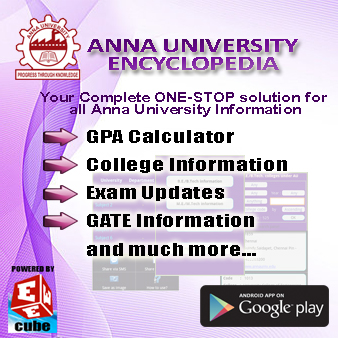SUBJECT RESOURCES:
CLICK HERE to access 'Question Banks'
CLICK HERE to access 'Previous Year Question Papers'
CLICK HERE to access '2 marks'
CLICK HERE to access 'Notes'
CLICK HERE to search more about this subject
SYLLABUS:
CLICK HERE to access 'Question Banks'
CLICK HERE to access 'Previous Year Question Papers'
CLICK HERE to access '2 marks'
CLICK HERE to access 'Notes'
CLICK HERE to search more about this subject
SYLLABUS:
EE2202 ELECTROMAGNETIC THEORY L T
P C
3 1 0 4
AIM
This subject aims to provide the student an understanding of the fundamentals of electromagnetic
fields and their applications in Electrical Engineering.
OBJECTIVES
To impart knowledge on
i. Concepts of electrostatics, electrical potential, energy density and their
applications.
ii. Concepts
of magnetostatics, magnetic flux
density,
scalar and vector potential
and
its
applications.
iii. Faraday’s laws, induced emf and their
applications.
iv. Concepts of electromagnetic waves and
Pointing vector.
UNIT I INTRODUCTION 8
Sources and effects of electromagnetic fields – Vector fields – Different co-ordinate systems- vector calculus – Gradient, Divergence and Curl
- Divergence theorem – Stoke’s theorem.
UNIT II ELECTROSTATICS 10
Coulomb’s Law – Electric
field intensity – Field due to point and continuous charges – Gauss’s law and application – Electric potential – Electric field and equipotential plots – Electric field in free
space, conductors, dielectric -Dielectric polarization - Dielectric strength - Electric field in multiple dielectrics – Boundary conditions,
Poisson’s
and
Laplace’s
equations
–
Capacitance- Energy
density.
UNIT III MAGNETOSTATICS 9
Lorentz Law of force, magnetic field intensity – Biot–savart Law - Ampere’s Law – Magnetic field due
to
straight conductors, circular loop, infinite sheet of current – Magnetic
flux density (B) – B in free space, conductor, magnetic materials – Magnetization – Magnetic field in multiple media – Boundary conditions – Scalar and vector potential – Magnetic force – Torque – Inductance – Energy density –
Magnetic circuits.
UNIT IV ELECTRODYNAMIC FIELDS 8
Faraday’s laws, induced emf – Transformer
and motional EMF – Forces and Energy in quasi- stationary Electromagnetic Fields - Maxwell’s equations (differential and integral forms) – Displacement current – Relation between field theory and circuit theory.
UNIT V ELECTROMAGNETIC WAVES 9
Generation – Electro Magnetic Wave equations – Wave parameters; velocity, intrinsic impedance,
propagation constant – Waves in free space, lossy and lossless dielectrics, conductors-skin depth,
Poynting vector
– Plane wave reflection and refraction – Transmission lines – Line equations – Input
impedances – Standing wave ratio and power.
L = 45 T = 15
TOTAL: 60 PERIODS
TEXT BOOKS:
1. Mathew N. O. SADIKU, ‘Elements of Electromagnetics’, Oxford University press Inc. First India
edition, 2007.
2. Ashutosh Pramanik, ‘Electromagnetism – Theory and Applications’, Prentice-Hall
of
India Private
Limited, New Delhi, 2006.
REFERENCES
1. Joseph. A.Edminister, ‘Theory and Problems of Electromagnetics’, Second edition, Schaum
Series, Tata McGraw Hill, 1993.
2. William .H.Hayt, ‘Engineering Electromagnetics’, Tata McGraw Hill
edition, 2001.
3. Kraus and Fleish, ‘Electromagnetics with Applications’, McGraw Hill International Editions, Fifth
Edition, 1999.
|
|










No comments:
Post a Comment
Note: Only a member of this blog may post a comment.